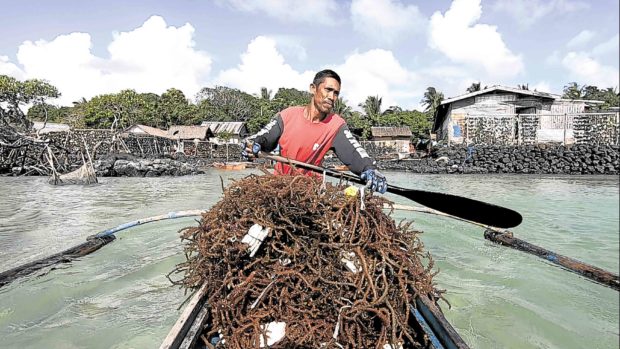
INCOME SOURCE: Small fishermen in Palawan depend on seaweed farming to support their families. Before Typhoon Odette (international name: Rai) struck in December last year, their farms, with an average size of 2,500 square meters, generated employment for around 85 percent of more than 17,000 coastal families in the province. (Photo by GEOFFREY DELAHAYE / Contributor)
PUERTO PRINCESA CITY, Palawan, Philippines — When Typhoon Odette (international name: Rai) battered central and northern Palawan in mid-December last year, coastal farmers lost all of the seaweeds they were growing, leaving them with very little to start with as they try to propagate a new batch of these marine plants.
Odette’s onslaught resulted in unprecedented agricultural damage of up to P3 billion throughout Palawan, affecting 5,532 seaweed farmers who rely primarily on their farms as their single source of livelihood.
Jhay-R Timbang, chair of Star of the North Agriculture Cooperative in the coastal village of Pularaquen in Taytay town, was among the thousands of individuals who are still struggling to recover from the impact of the typhoon, the strongest to have hit the country last year.
Timbang, along with thousands of coastal farmers throughout the province whose seaweed farms had been decimated, received P2,000 as aid from the provincial government.
“We received P1,000 earlier today (Feb. 14). This is already the second batch from the local government. The first was food assistance also worth P1,000,” he said in a text message on Monday.
“Typhoon Odette destroyed all of our seaweeds. Until today, we are still trying to recover—salvaging what’s left because we do not have source of seedlings to start our production again,” Timbang said in an earlier interview.
Seedlings needed
Like some seaweed farmers in their local cooperative, Timbang was forced to find other alternative sources of income to provide for the needs of his family. He has been raising native chickens, he said.
However, the farmers remained primarily concerned on rehabilitating their seaweed farms, lacking available seedlings (propagules/cuttings) locally.
Rodrigo Longcayana, leader of seaweed farmers in Sitio Amogues in the coastal village of Calawag in Taytay, also cries for help with almost P2 million losses in seaweed facilities and agrifisheries machinery.
“We wanted to know how to get help because if this continues, we will be helpless for years to come. We are asking help from everyone who can and willing to help us,” he said.
Provincial agriculturist Romeo Cabungcal said Odette severely affected the province’s agriculture sector, particularly its high-value crops and agrifisheries.
AWAITING REHAB: In this photo taken in January, seaweed farms at Sitio Amogues in the coastal village of Calawag in Taytay town, have yet to be rehabilitated after Typhoon “Odette” battered northern Palawan in December 2021. —GEOFFREY DELAHAYE/CONTRIBUTOR
Top producer
“We are prioritizing here the provision of seaweed seedlings but the problem is we don’t have a source in the province where we could get the seedlings. We will be sourcing out from other provinces,” Cabungcal said in an interview early this month.
Data from the Department of Agriculture’s Bureau of Agricultural Statistics showed that since 2008, Palawan has been the top producer of seaweeds in the country with 444,355.44 metric tons, comprising around 27 percent of the national production.
Seaweed farming in the province is dominated by small farmers, with an average farm size of 2,500 square meters (0.25 hectare), generating employment for around 85 percent to 90 percent of 17,459 coastal families.
‘Floating bank account’
Seaweed is a cash crop, which locals usually refer to as a “floating bank account,” because they are assured of income as long as they can harvest seaweed. A line of seaweed can be propagated into 10 lines in just six months, giving farmers a choice of expanding their farm quickly, selling for cash or trading for goods.
Ordinary seaweed price ranges between P12.50 and P13 a kilo for low-class seaweed species like “butay,” “espinoso” and “milyon-milyon.” The giant brown-orange seaweed, locally known as “sakul,” is the most sought after, its price ranging from P42 to P50 a kilo.
During the peak season between April and May, prices would even reach up to P80 to P100 a kilo, with each seaweed roll generating up to P6,000 per farmer.
RELATED STORY
DTI, DA vow millions worth of aid to Palawan residents affected by ‘Odette’